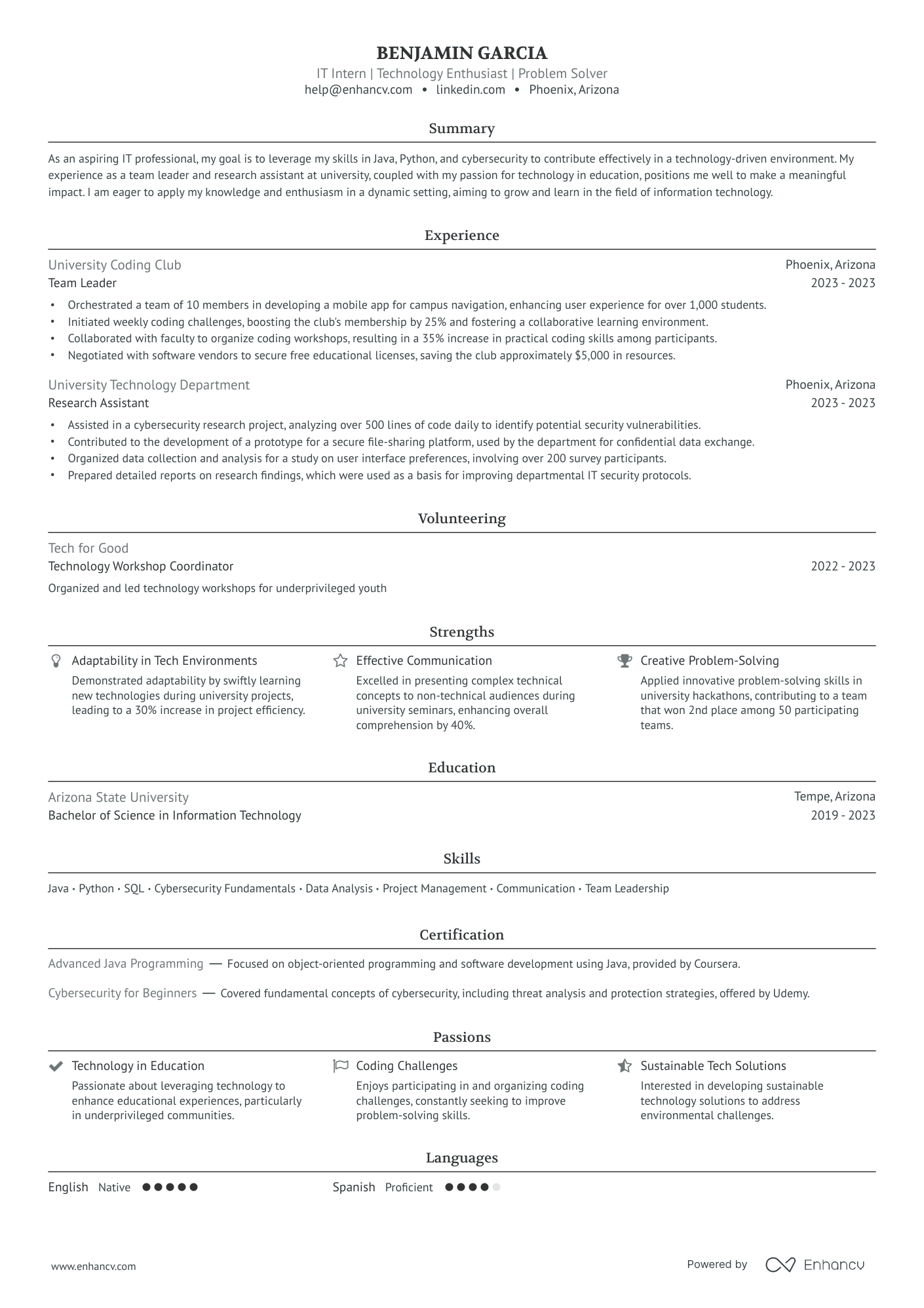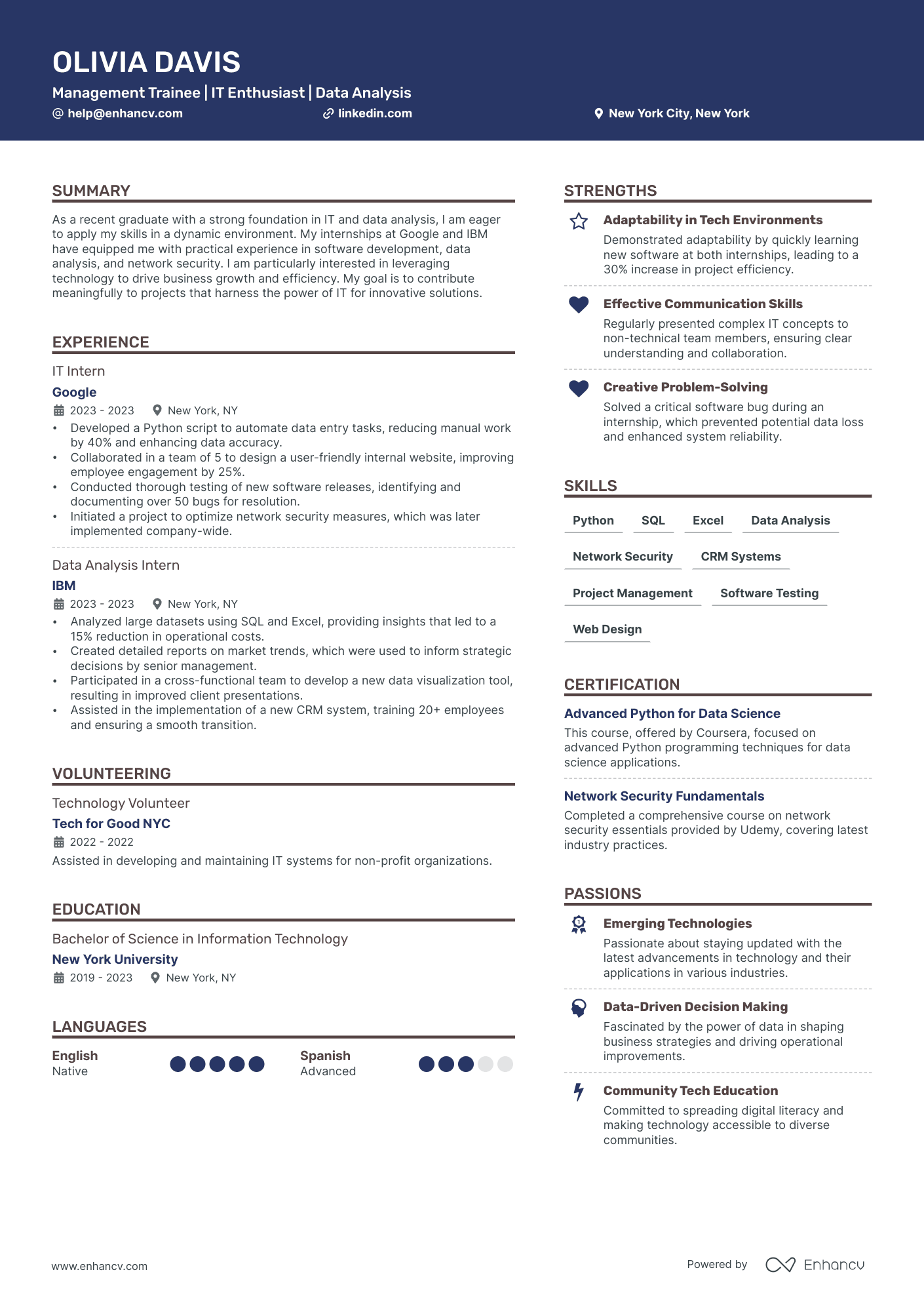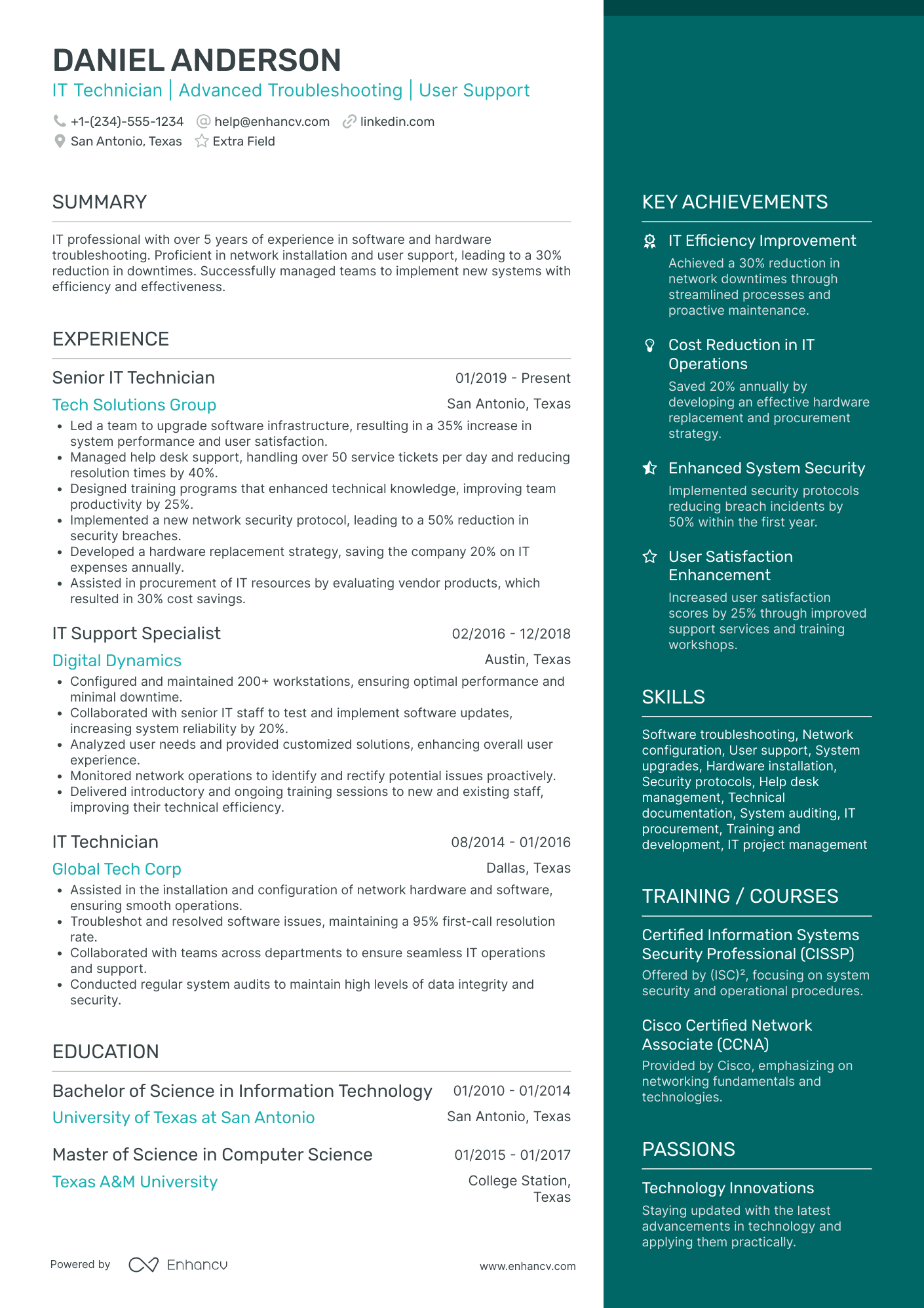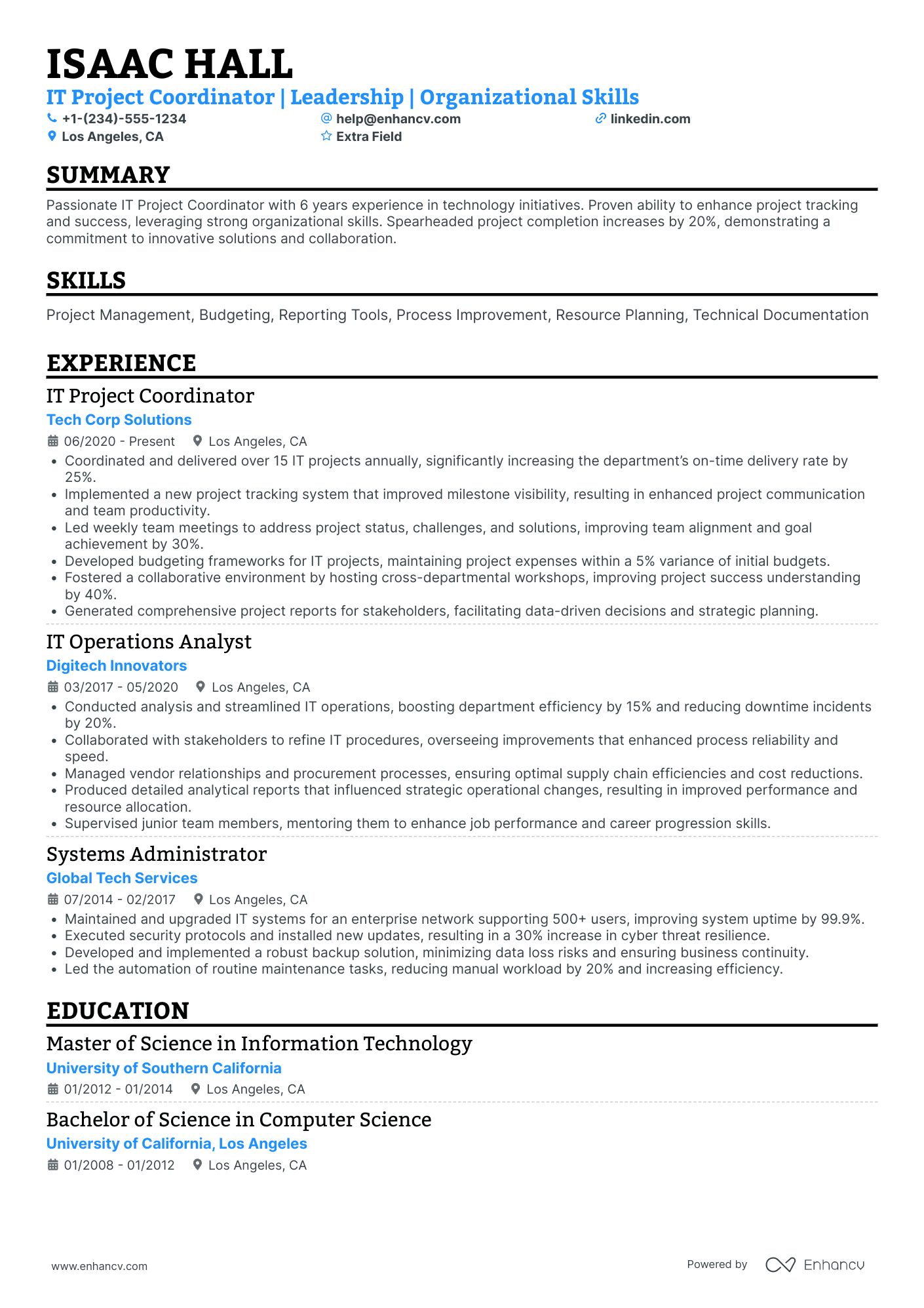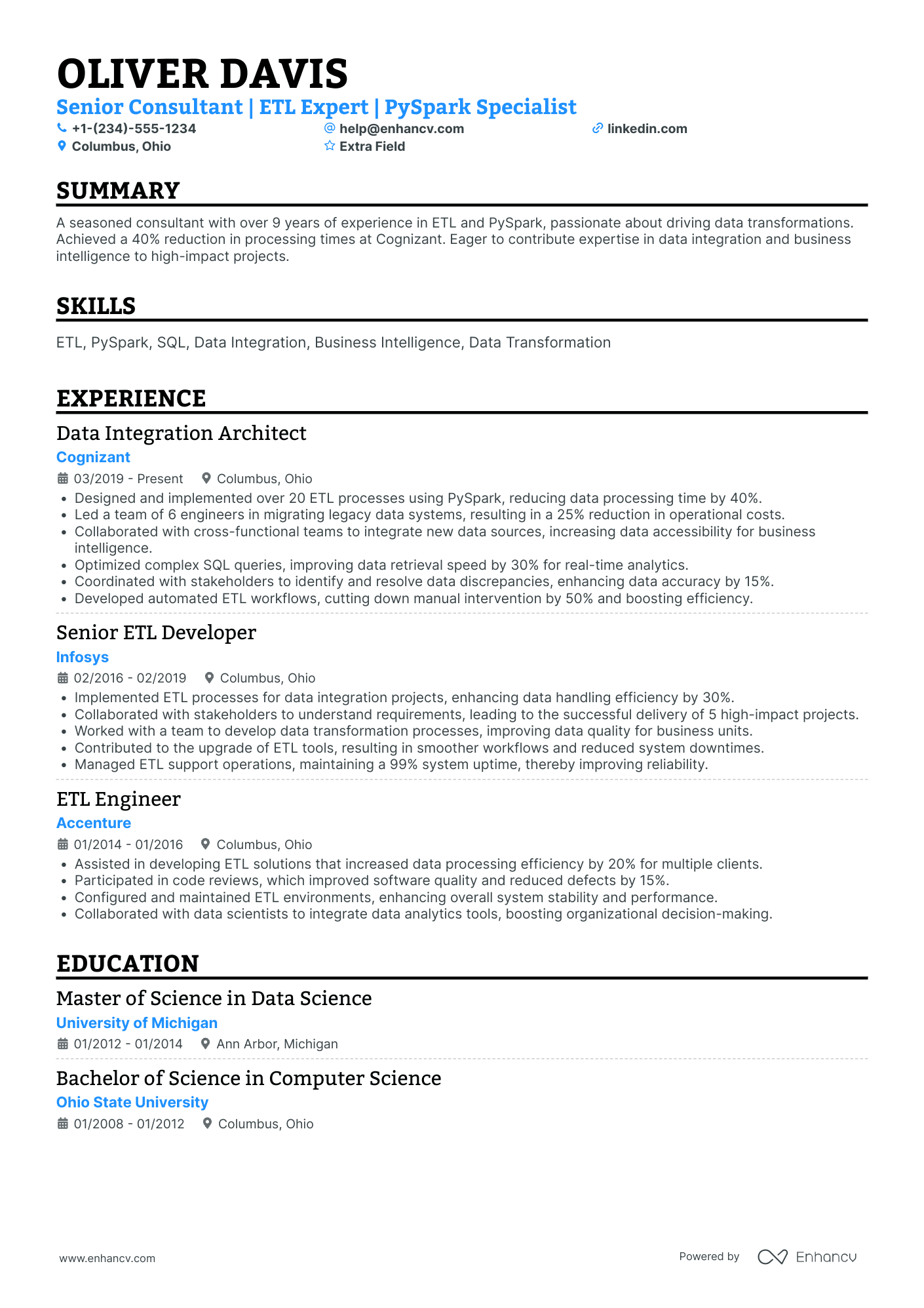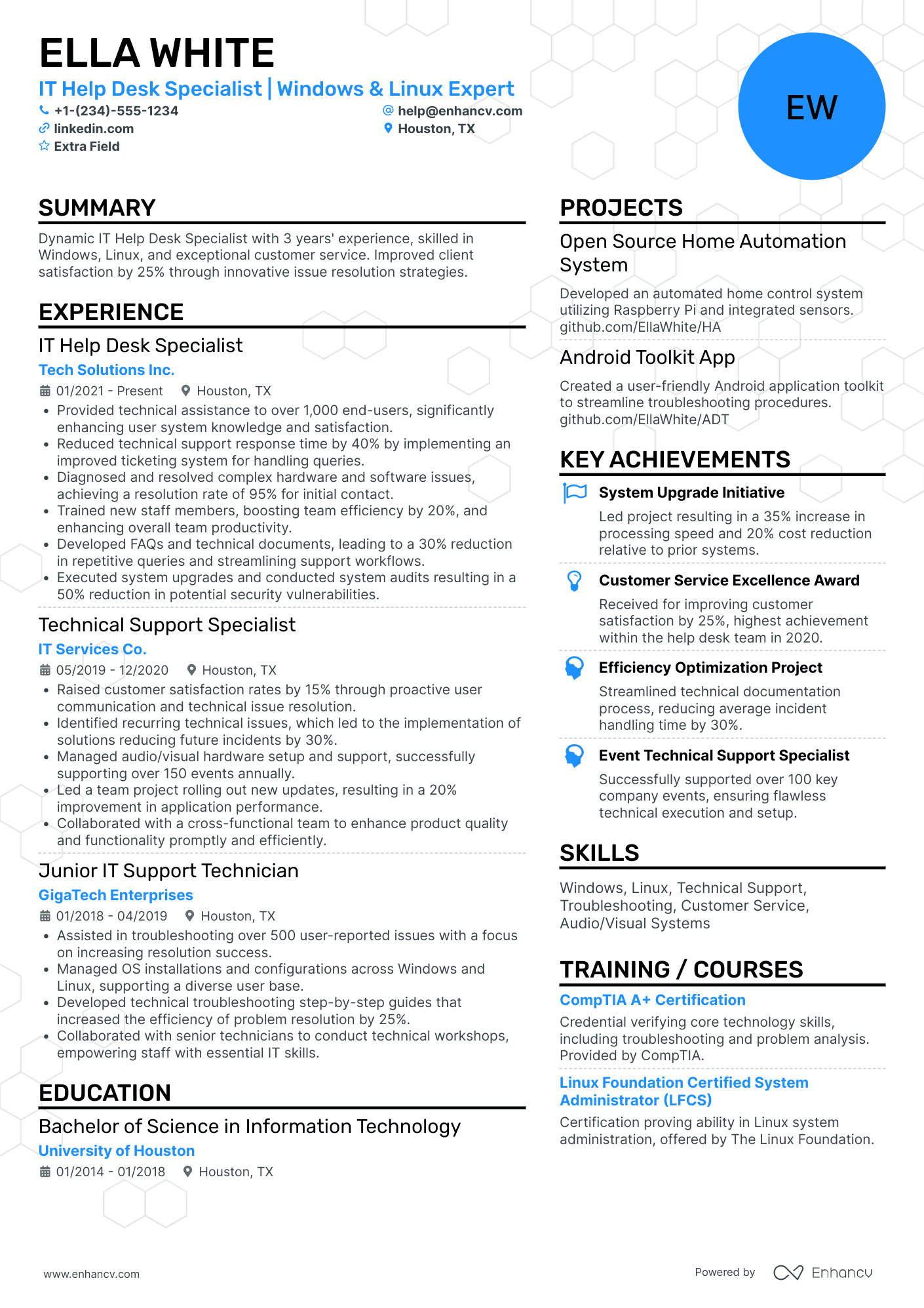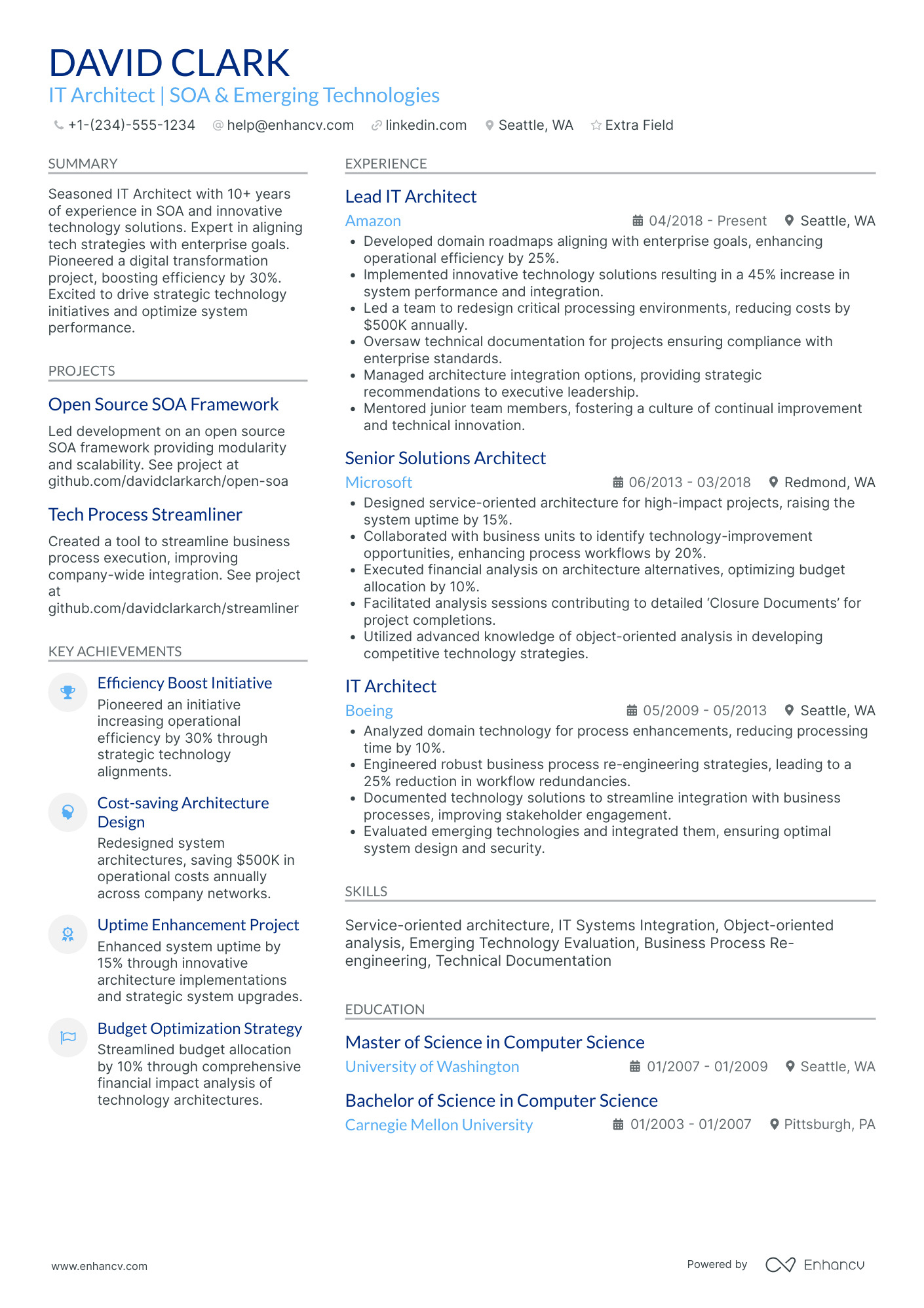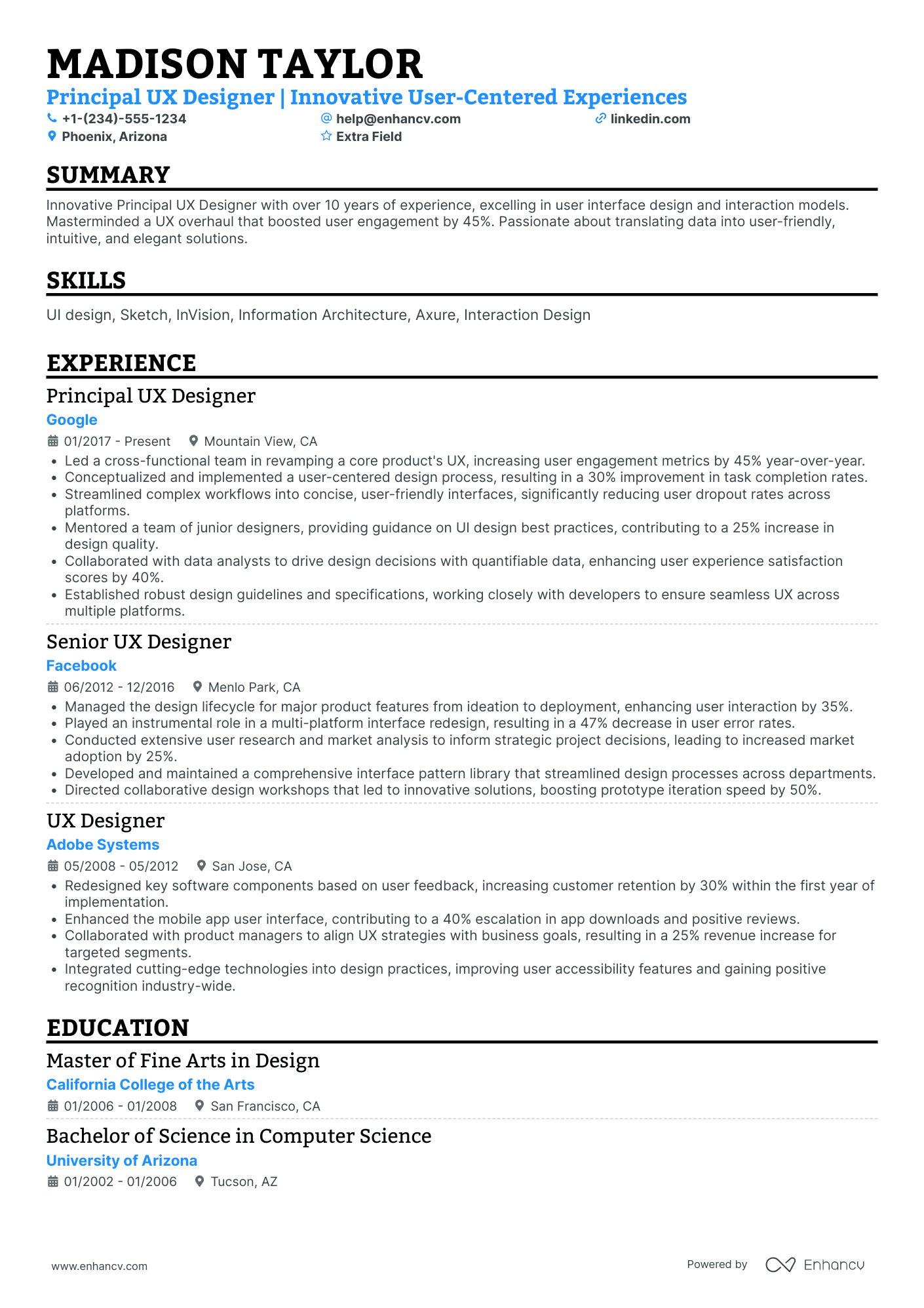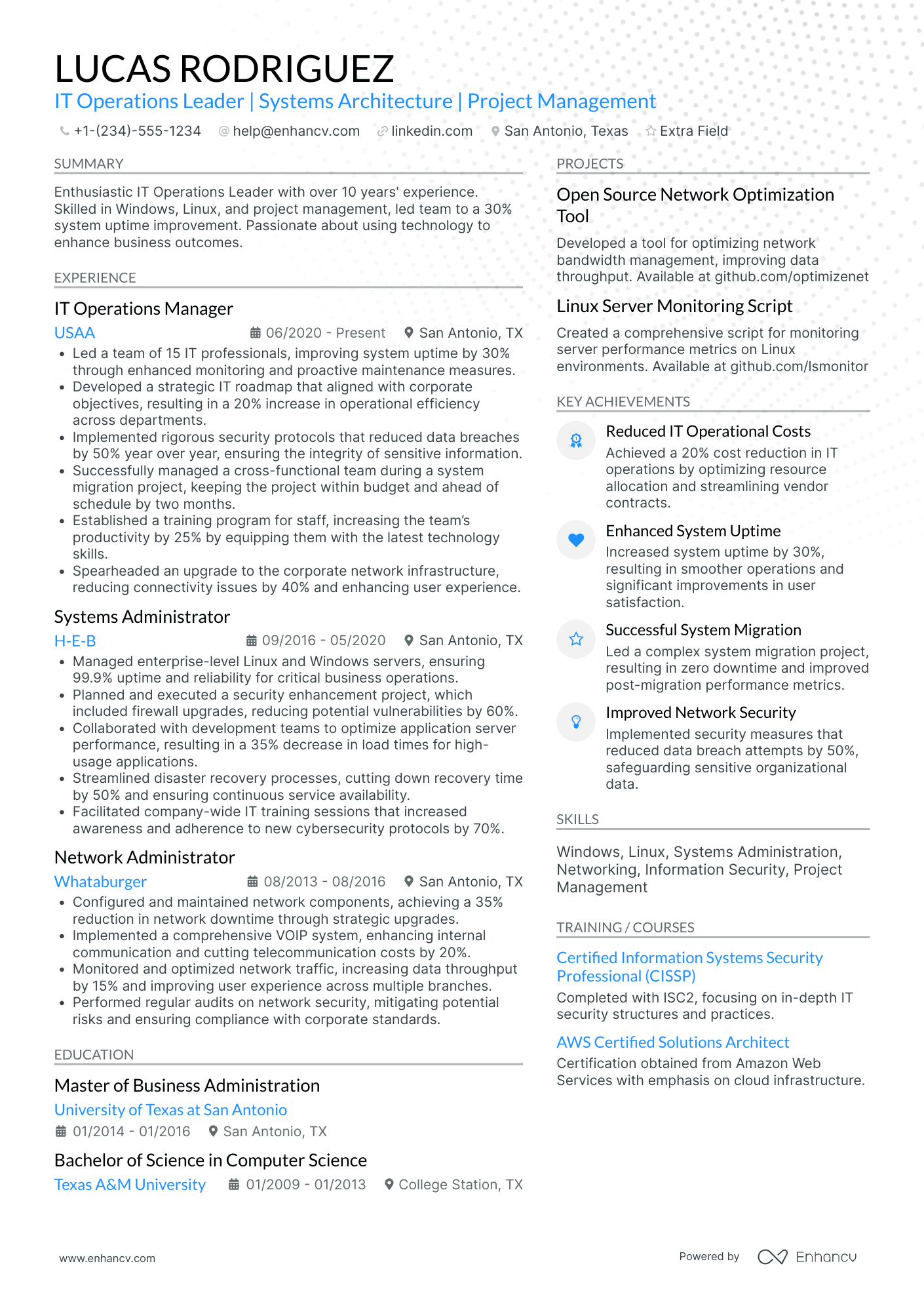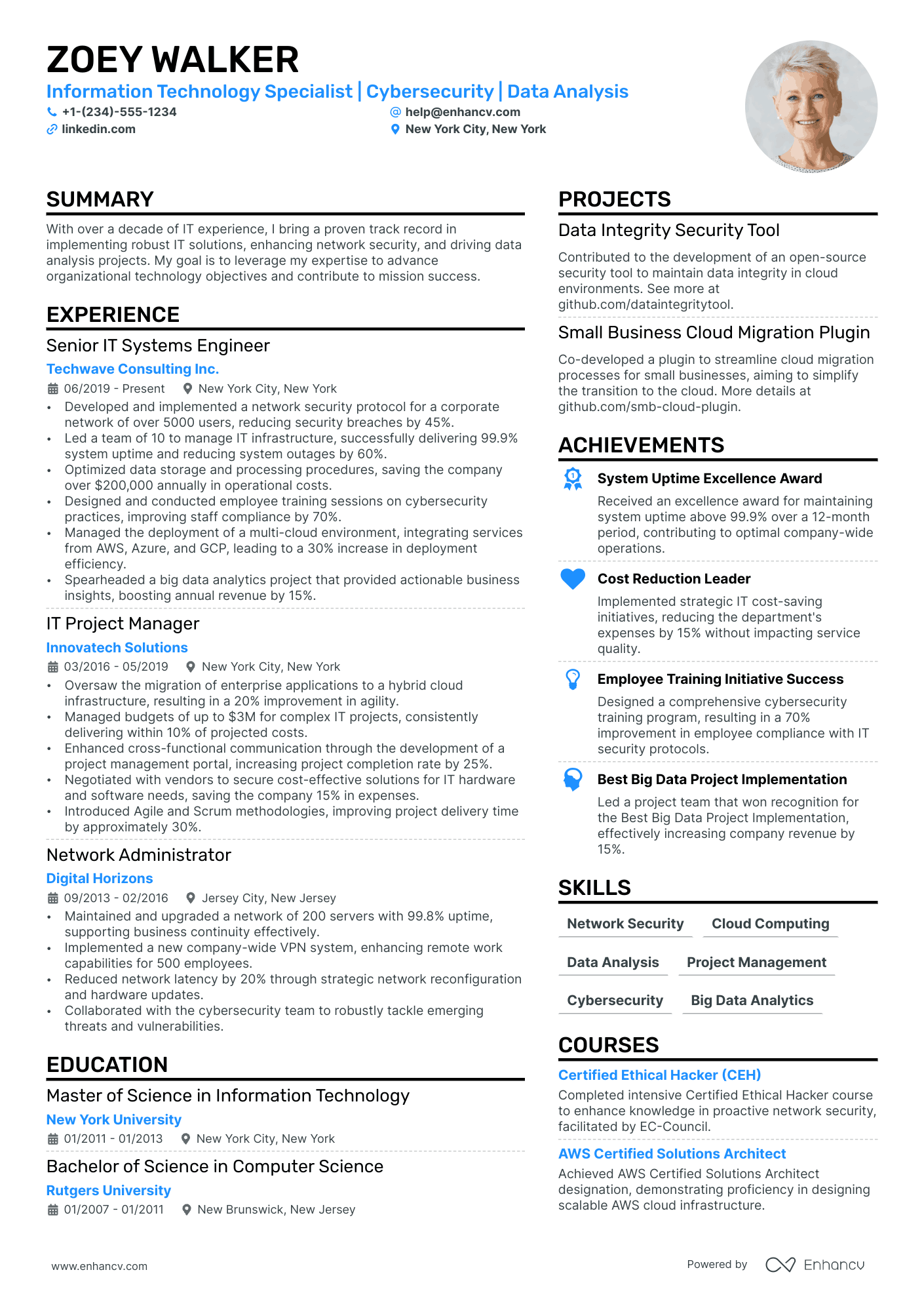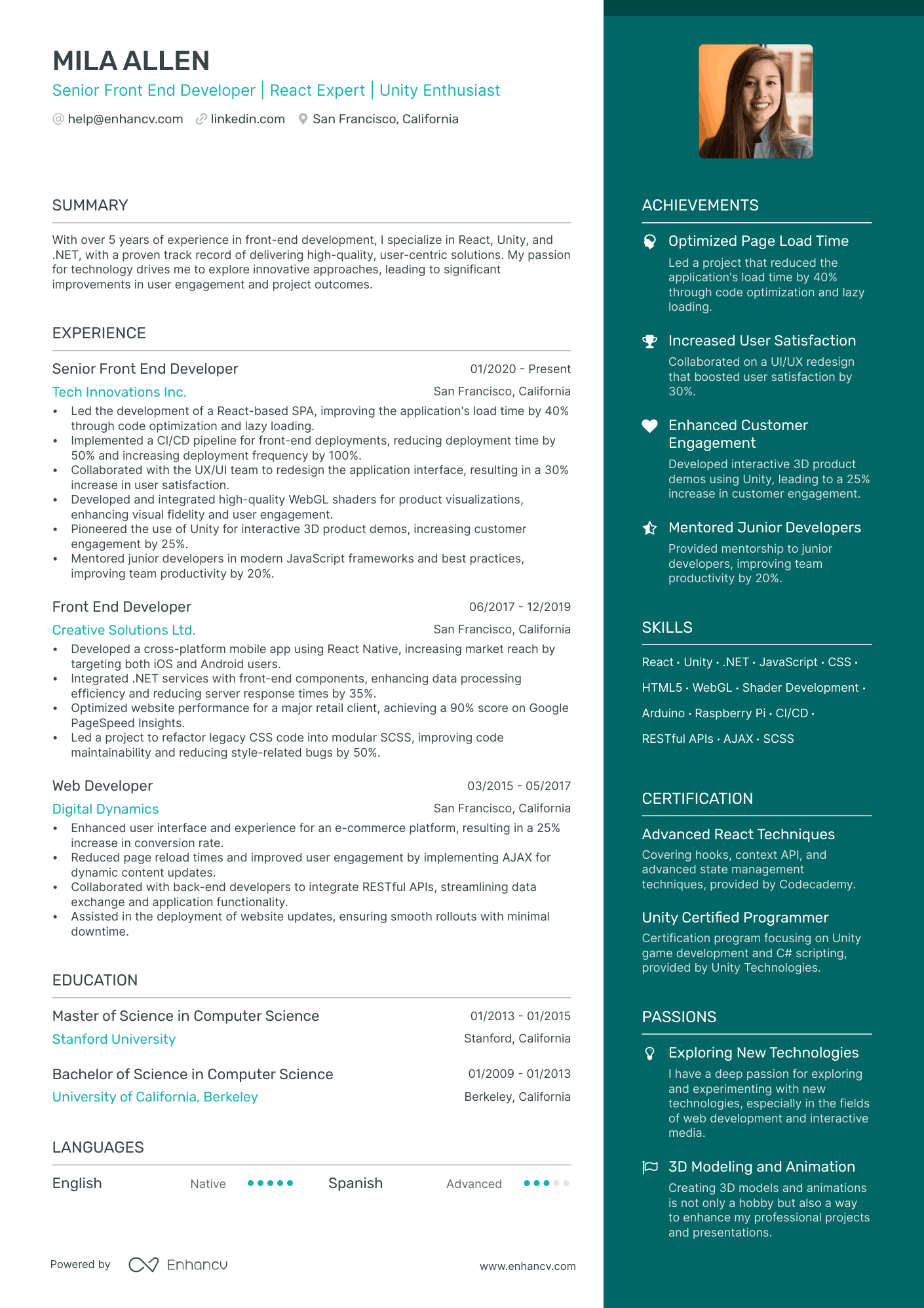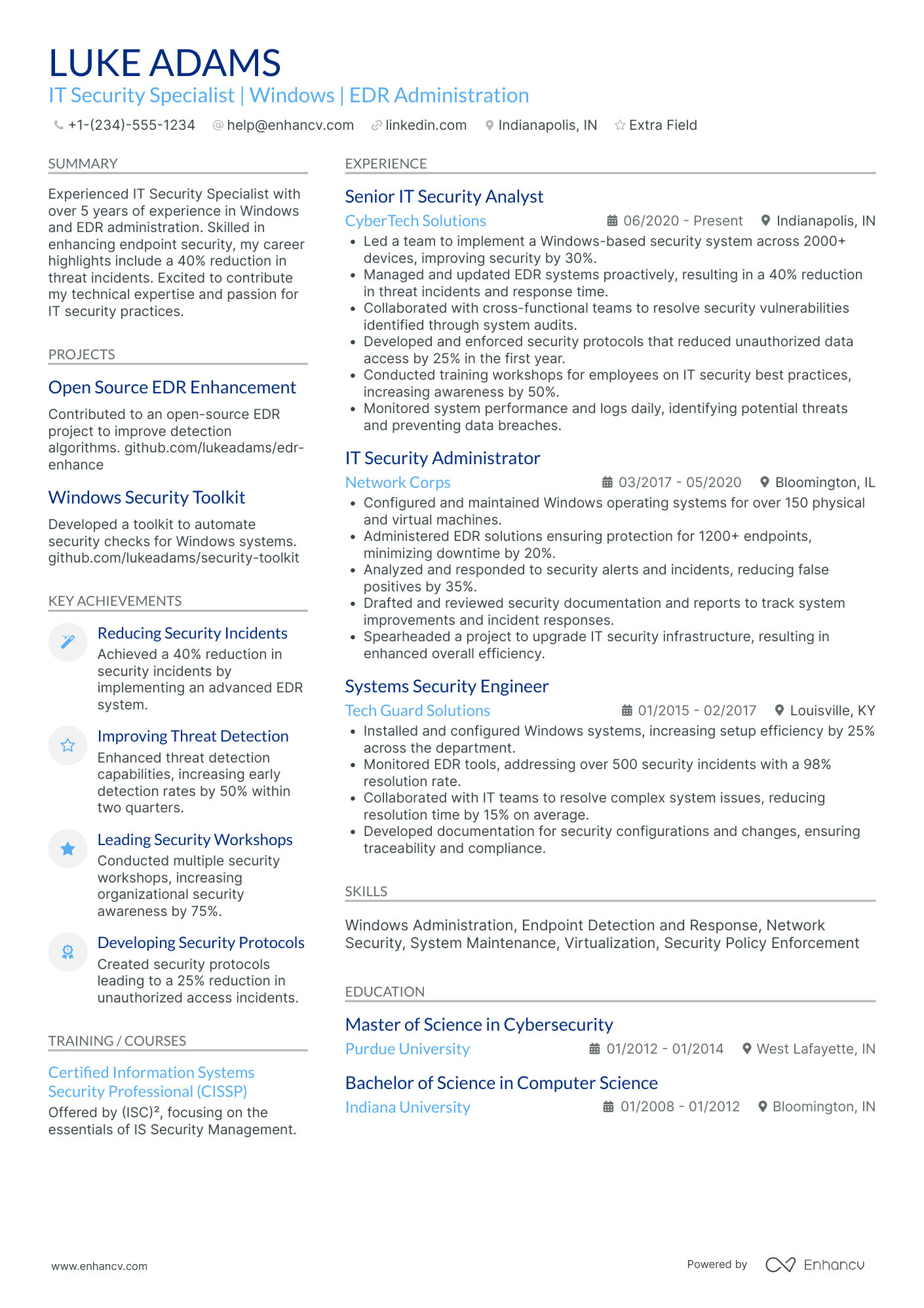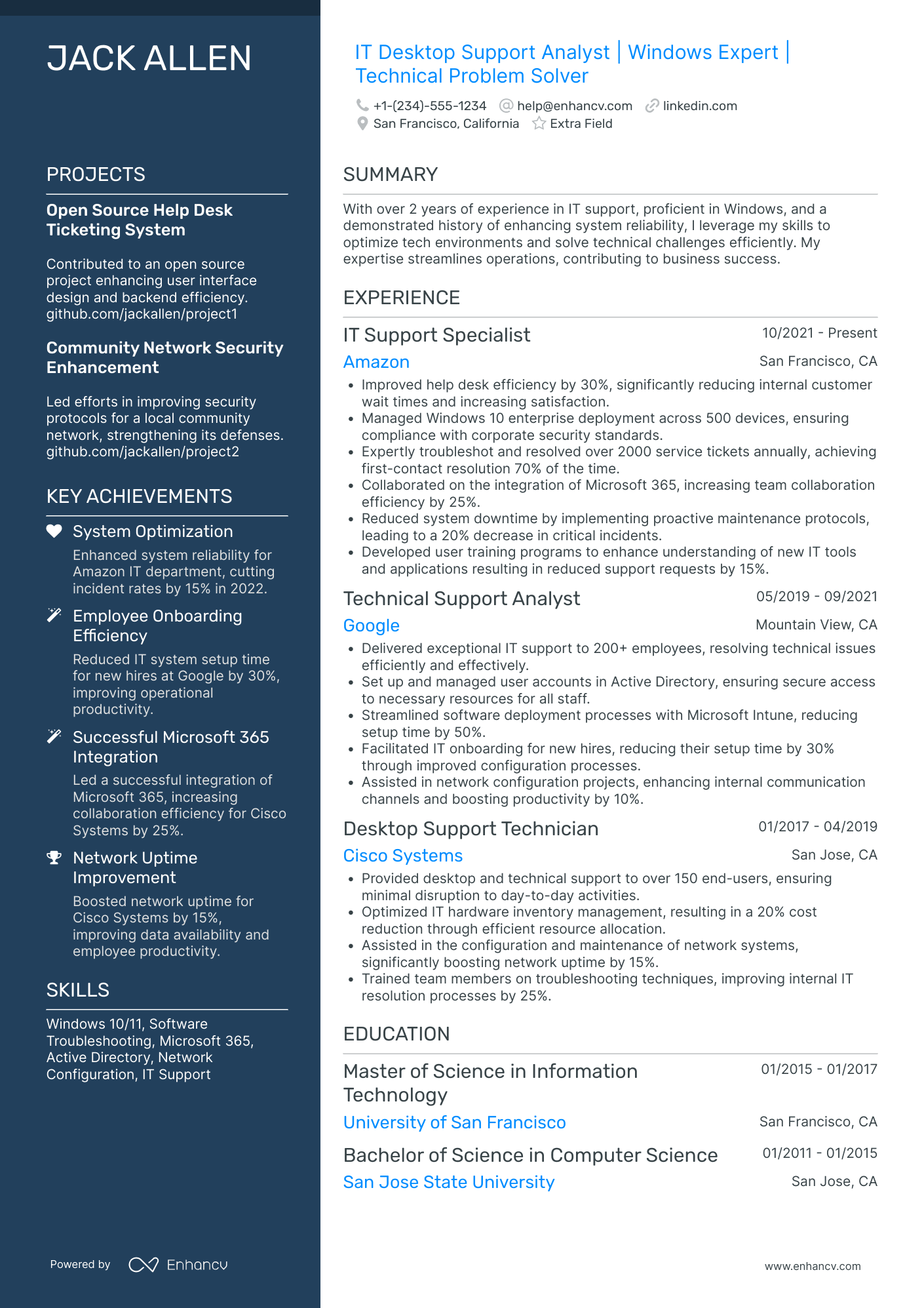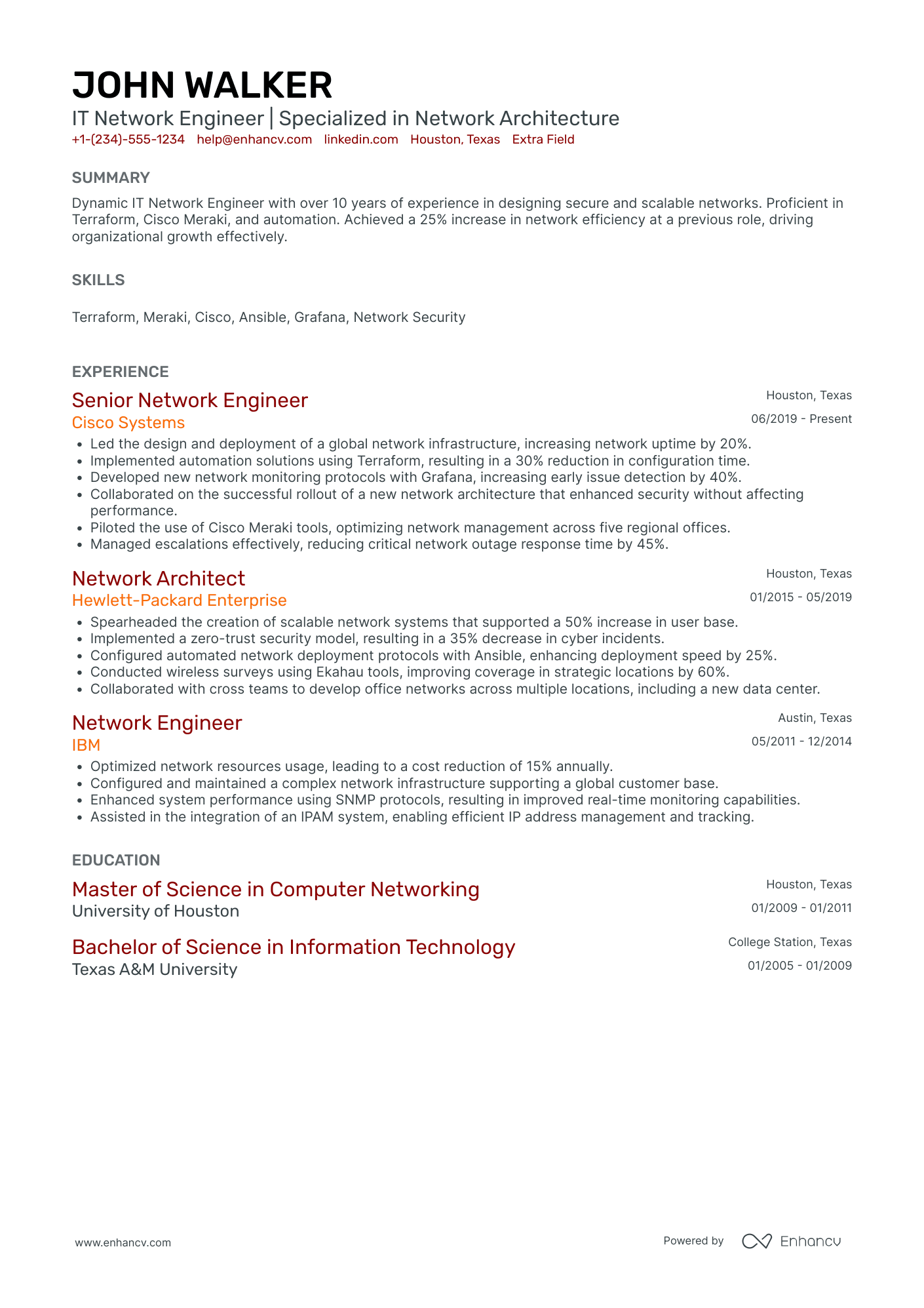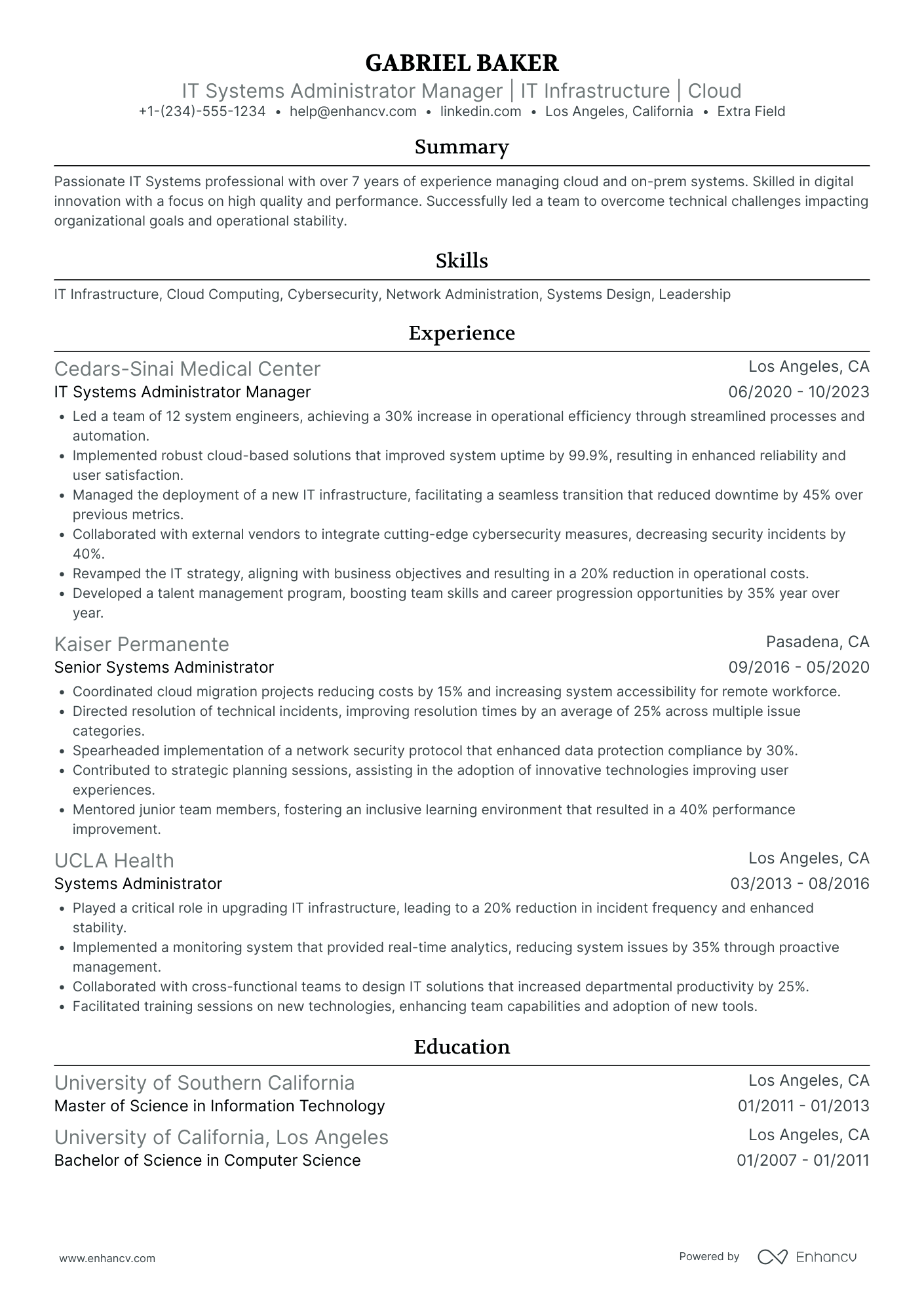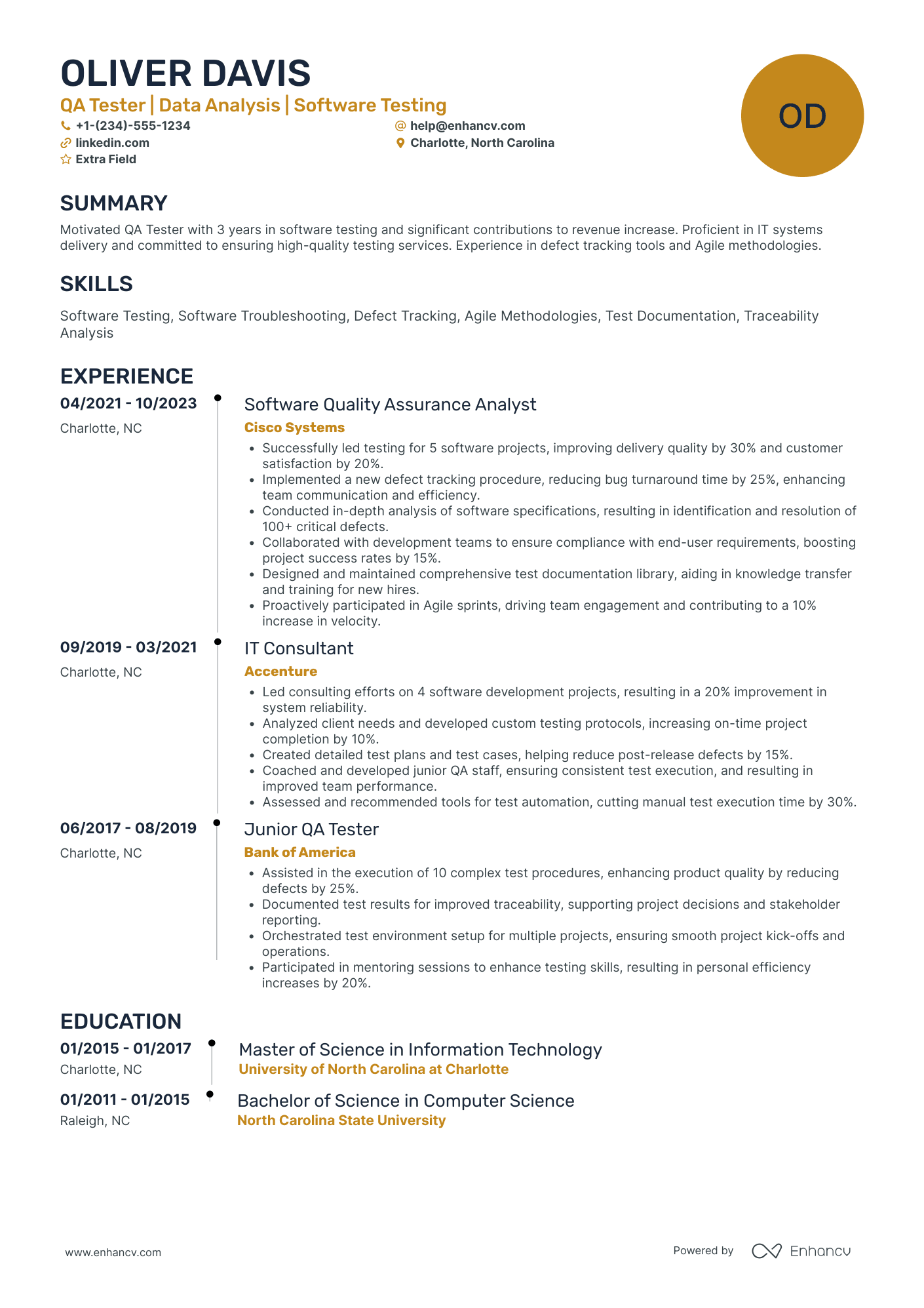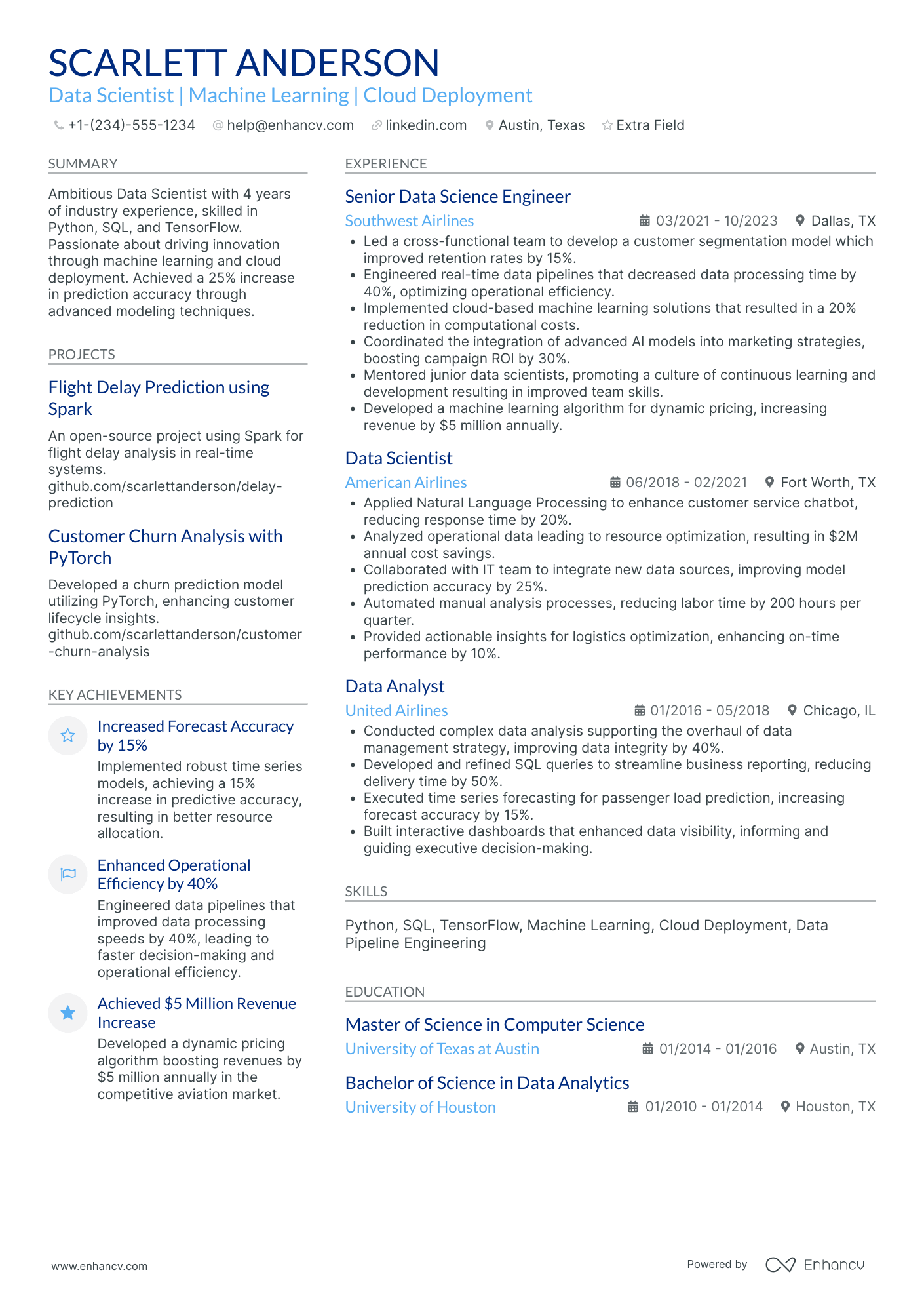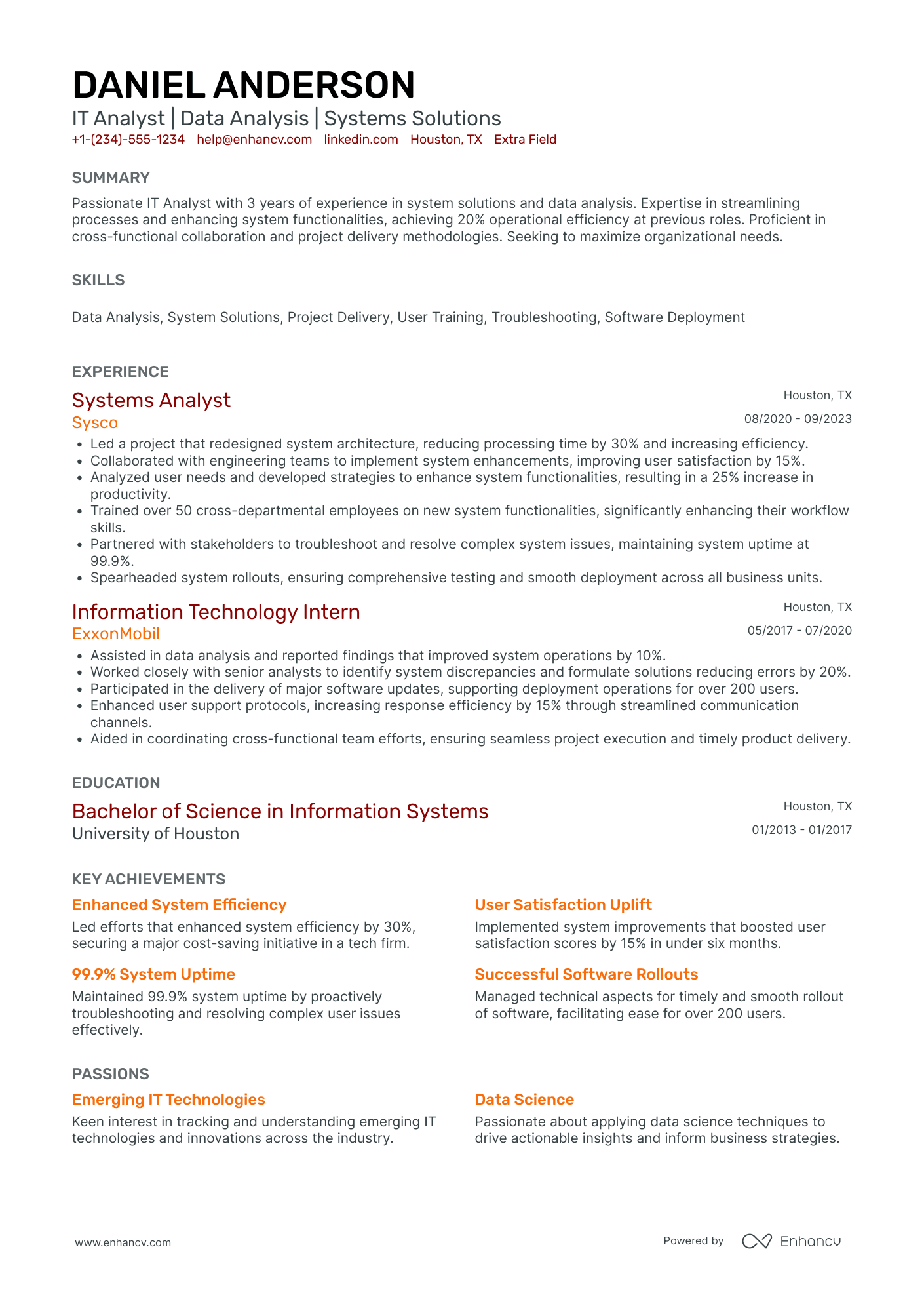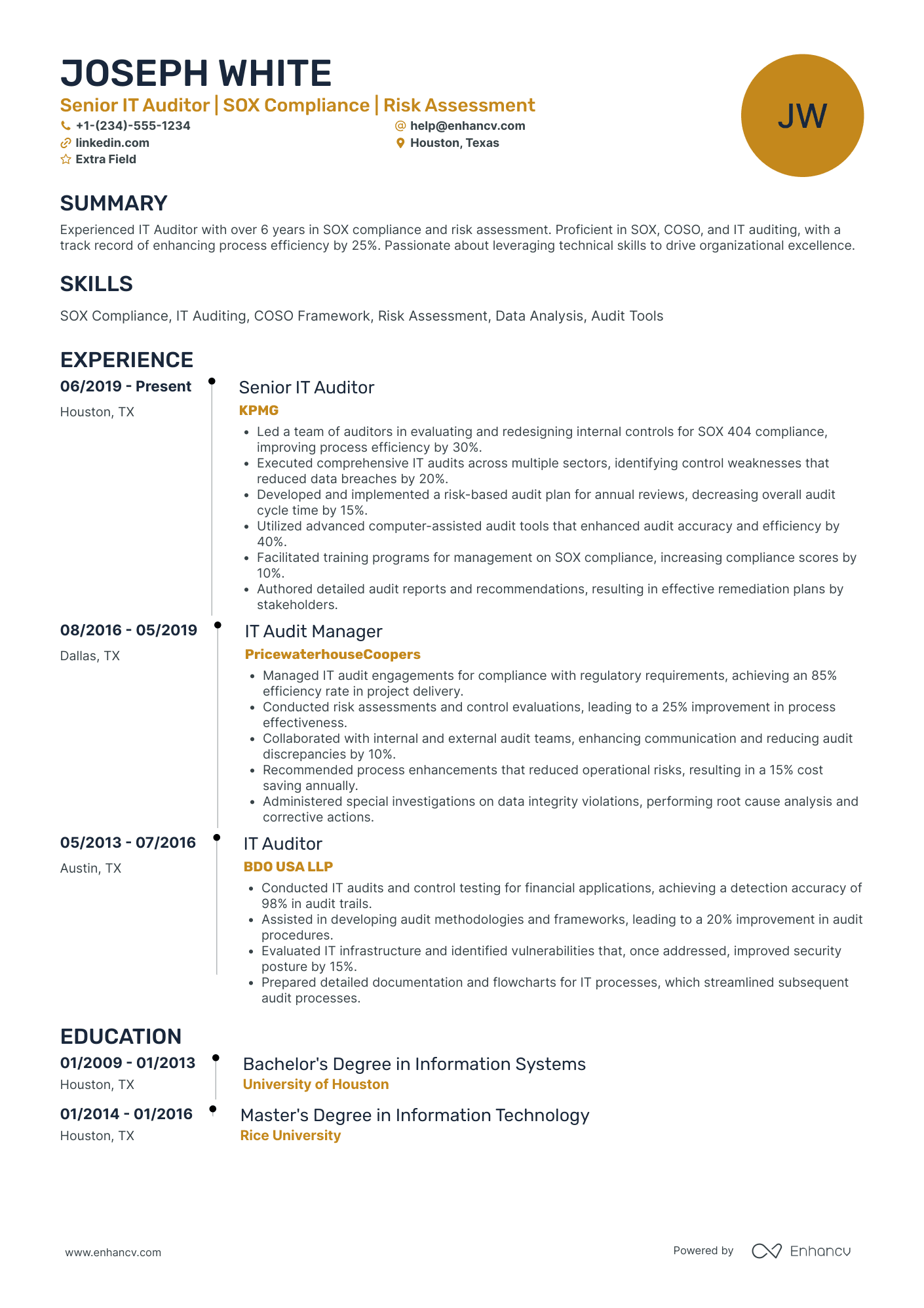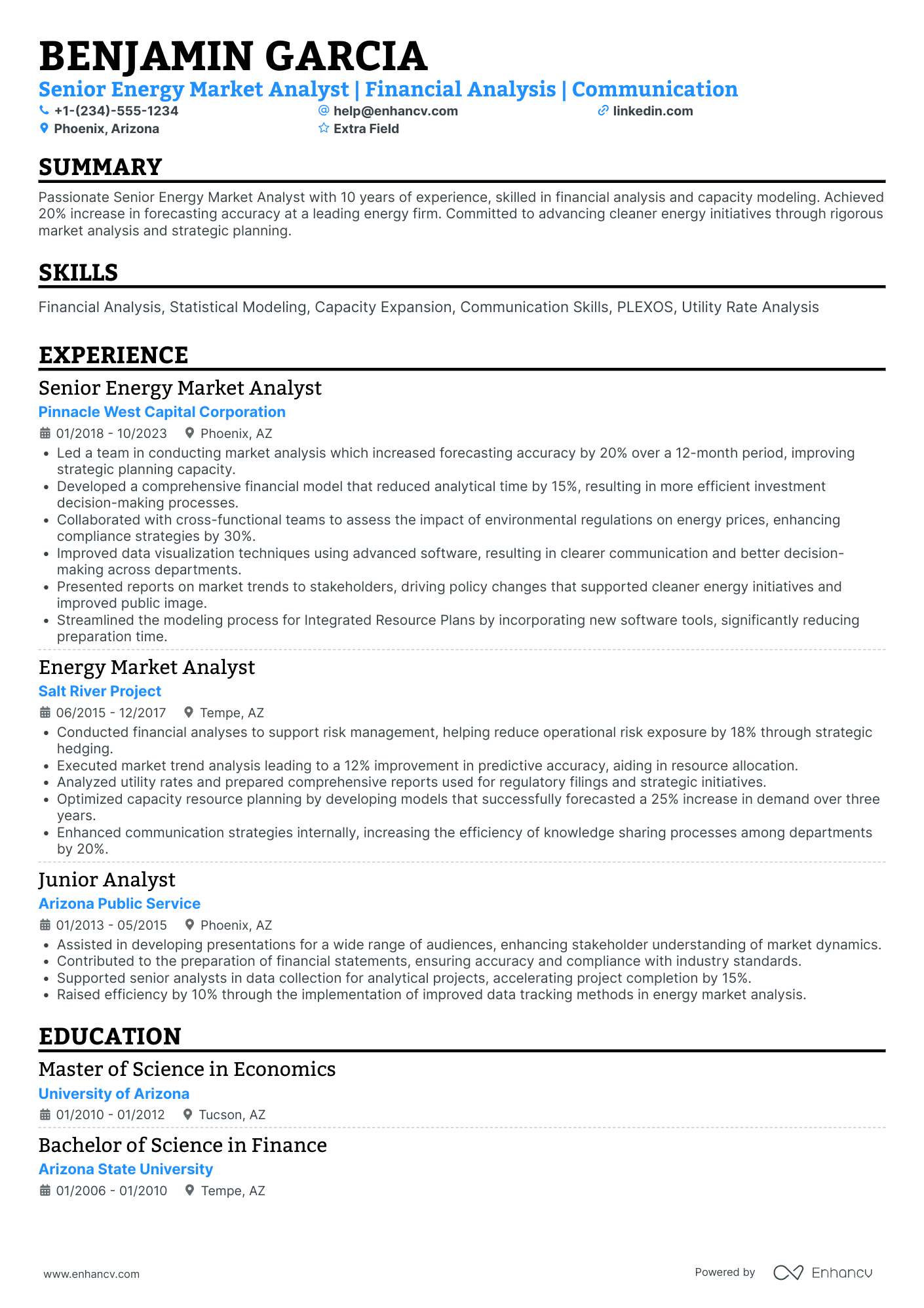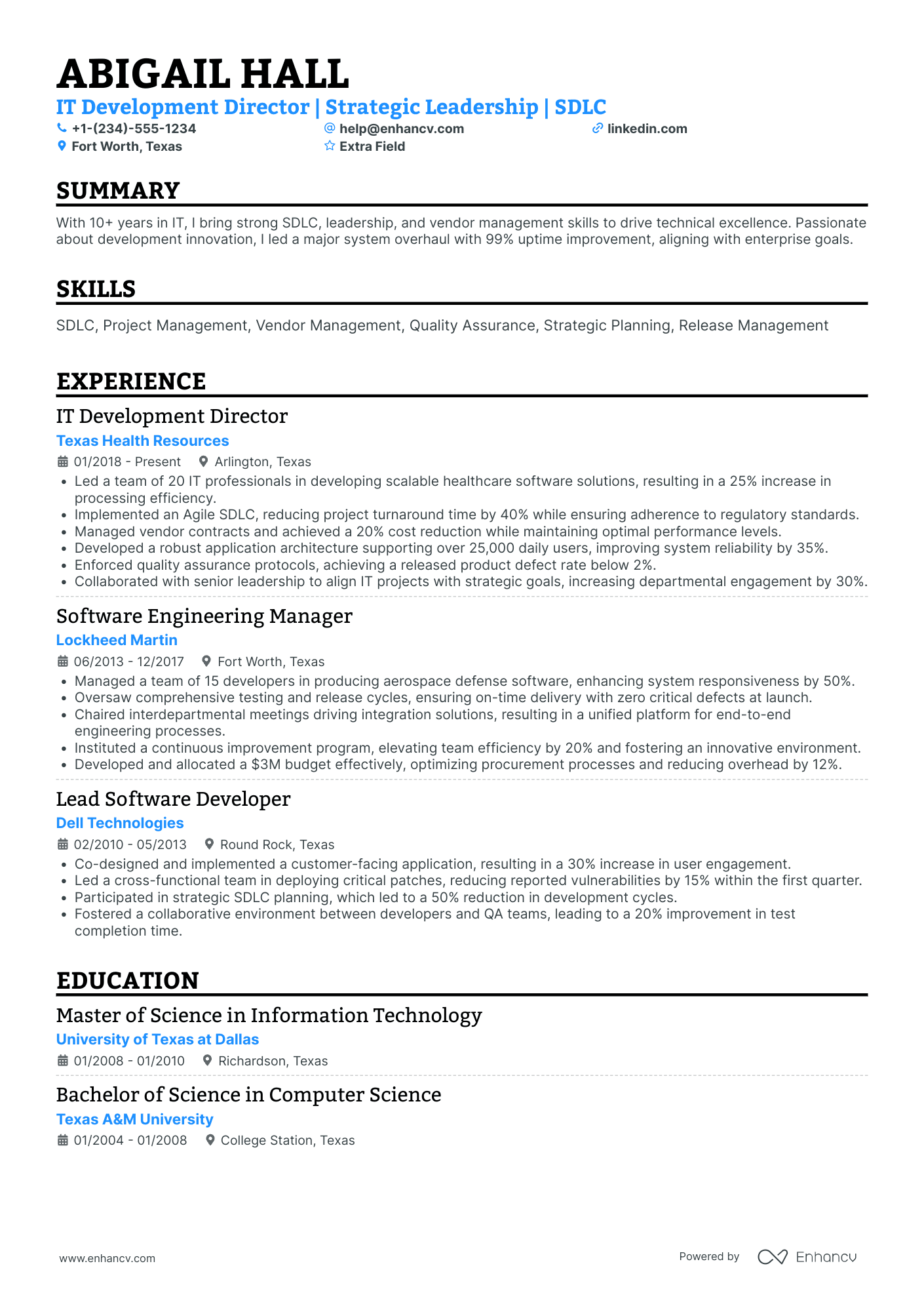Navigating the competitive landscape of Information Technology (IT) job hunting is akin to upgrading your system to the latest software—it’s all about optimizing for performance.
According to the U.S. Bureau of Labor Statistics, employment in computer and IT is projected to grow much faster than all other occupations from 2022 to 2032, so standing out with a stellar resume isn't just recommended; it's essential. While fields like manufacturing or retail might emphasize years of experience or management roles, the IT sector prioritizes technical prowess, certifications, and cutting-edge skills.
We cannot emphasize enough the importance of displaying the unique blend of skills, achievements, and passion for technology that your resume must convey to catch a recruiter’s eye in the dynamic IT field.
Let's dive into crafting an IT resume that not only ticks all the boxes but also tells your story in the language of innovation.
In this article, we’ll go over the following elements and why it’s crucial to:
- Choose the right format for your Information Technology resume whether you need to highlight career progression, emphasize skills, or showcase both skills and experience.
- Detail work experiences that highlight technical skills and achievements.
- Use quantifiable metrics and relevant keywords and integrate both soft and hard skills.
- List education and certifications to effectively demonstrate your foundational knowledge and your commitment to the industry.
- Craft a resume summary or objective to introduce your skills and professional narrative.
Need a more specific guide? Try one of these or search our resume example page for the particular job you’re after:
In the IT industry, competition has become so fierce that it favors only the best.
Azim Premji, Founder of Wipro Technologies
With that said and done, let’s continue on our path and explore some different resume formats.
How to format an informational technology resume
Choosing the correct resume format for the Information Technology (IT) sector is crucial because it helps highlight your strongest assets, whether that's your technical skills, professional experience, or a combination of both. The IT field is diverse and rapidly evolving, so your resume needs to reflect your specific strengths and how they align with the job you're applying for.
The format you choose can significantly impact a hiring manager's first impression and your resume's overall effectiveness in demonstrating your suitability for the role.
To choose the most appropriate format, consider your background and the position's requirements:
- Reverse chronological format: Perfect for candidates with a strong, directly relevant work history. It presents work experience in reverse chronological order, emphasizing professional growth and achievements. This format suits those whose IT career shows clear progression, highlighting advancements and increasing responsibilities.
- Functional/Skills-based format: Ideal for career changers, those with employment gaps, or entry-level candidates with limited experience. This format emphasizes technical skills and abilities over career chronology, spotlighting IT competencies and relevant projects.
- Combination/Hybrid format: This format combines chronological and functional styles, showcasing your technical skills and work history. It's ideal for highlighting a robust IT skill set alongside a detailed work history, perfect for individuals with diverse IT roles, significant projects, or those targeting mid-level to senior positions where technical and leadership skills are crucial.
To choose the best format, align your resume with the job description. Use keywords and highlight experiences that match the employer's needs. For IT roles, emphasizing technical skills, certifications, and relevant projects is often vital, so consider a format that allows these elements to take precedence.
PRO TIP
Regardless of the format, ensure your resume is clear, concise, and tailored to the role, demonstrating both your technical capabilities and how they translate into business value.
Optimizing your IT sector resume layout not only involves highlighting your skills and experiences but also ensuring the document is professionally designed, easily readable, and ATS-friendly. Here's how to approach these aspects:
Resume design
- Keep margins on your resume between 0.5 inches and 1 inch on all sides. This ensures your resume looks tidy and maximizes space.
- Use color on a resume sparingly to highlight headings or important details, but stick to one or two colors. Shades of blue, gray, or green are generally safe and convey a professional image.
- Choose clean, professional resume fonts like Arial, Calibri, or Rubik. Keep your font size between 10 and 12 points for the body text and slightly larger for headings (H2).
- A one-page resume with plenty of experience won’t fit on a single-column template. At Enhancv, our double-column template is specifically designed to meet applicant tracking systems requirements with one-page resumes in mind. The length for most IT professionals shouldn’t go over two pages. Focus on recent, relevant experiences and be concise.
Resume header
- Including your full address in the resume header is no longer necessary—listing your city and state is sufficient. Also, be sure to clearly have your email and phone number so the recruiter can easily contact you for an interview.
- Include links to your LinkedIn profile, GitHub, or personal website if they’re professionally relevant and well-maintained. Ensure your LinkedIn profile complements your resume.
- Generally, photos aren’t recommended on resumes in the U.S. due to equal employment opportunity regulations.
ATS compatibility
- For an ATS-friendly resume, incorporate keywords from the job description relevant to skills, technologies, and qualifications.
- Avoid footers, tables, or graphics as these can confuse ATS scans. Stick to standard resume sections.
File formatting and naming conventions
- Save your resume as a PDF to preserve the formatting, unless the job listing specifies a Word document. PDFs are also generally ATS-friendly.
- Use a clear, professional naming convention for your resume file, such as "FirstNameLastNameResume.pdf".
By following these guidelines, your resume won’t only be visually appealing and easy to read but also compatible with the automated systems that many companies use to screen candidates.
Want to check how your current resume holds up? Let Enhancv’s resume checker be the judge.
Is your resume good enough?
Drop your resume here or choose a file. PDF & DOCX only. Max 2MB file size.
Resume creation can often seem overwhelming, so we have put together the top five sections on an IT sector resume that you should dedicate the majority of your time and energy to perfecting.
The top sections on an IT resume
- Technical skills: Showcases expertise in specific programming languages and tools.
- Professional experience: Details past roles, projects, and achievements.
- Education & certifications: Highlights relevant academic background and IT certifications.
- Projects: Demonstrates hands-on experience with real-world applications.
- Achievements: Showcases awards and recognitions, underscoring your expertise and contribution to the field.
Besides giving those sections your full attention, also remember that recruiters are looking out for specific criteria while reading your resume. Here are some note-worthy elements to highlight as you craft yours:
What recruiters want to see on your resume
- Relevant technical skills: Recruiters prioritize these because they indicate the candidate's capability to perform the specific technical tasks required by the role.
- Certifications: Certifications are highly valued as they validate the candidate's skills and knowledge in particular technologies or methodologies.
- Problem-solving ability: Essential for IT roles, as these professionals are often required to find solutions to complex technical issues.
- Experience with specific technologies: Recruiters look for experience with tools and technologies specific to the job to ensure a candidate can contribute immediately.
- Project management experience: Demonstrates the candidate's ability to manage tasks, deadlines, and work within a team, crucial for IT projects.
With the topic of resume formats thoroughly covered, it’s time to now look at the individual sections. No better place to start than perhaps the most important of them all—work history.
How to write your IT resume experience
The inclusion of a work experience section on an IT sector resume is beyond compare because, like a backbone, it supports your claim to the throne in the tech kingdom.
It's not just about listing jobs; it's about showcasing your epic quests in the realm of technology. Think of your work history as the plot of your professional saga – without it, you're just a character without a story.
Tips to follow
When listing your IT work history, it's essential to display your technical skills and experiences as well as structure them in a way that captures the attention of recruiters and hiring managers. Here are some industry-specific tips to help you stand out:
- Prioritize relevance and impact
Start with your most recent job and work backward, but prioritize relevance to the job you're applying for. Highlight roles and projects that showcase your proficiency in the technologies and skills the job listing emphasizes.
- Quantify achievements
Use numbers to make your accomplishments stand out. For instance, mention how you improved system efficiency by a certain percentage, reduced downtime, or managed a team to deliver a project under budget. Quantifiable achievements offer concrete evidence of your impact.
- Use keywords from the job description
Many companies use Applicant Tracking Systems (ATS) to filter resumes. Incorporate keywords and phrases from the job listing into your work history to ensure your resume makes it past these filters and catches the eye of a human recruiter.
- Detail your technical skills and tools
Specify the technologies, programming languages, and tools you've used in each role. Be specific about your expertise areas, such as cloud services (AWS, Azure), programming languages (Python, Java), or cybersecurity protocols.
- Highlight your problem-solving capabilities
Informational Technology is all about solving problems. Provide examples of how you've identified issues, developed solutions, and implemented them successfully. This could be anything from optimizing a database to resolving security vulnerabilities.
- Showcase soft skills
Technical prowess is crucial, but so are soft skills. Demonstrate your ability to work in a team, communicate effectively, and manage projects or personnel, especially for senior-level positions.
- Mention relevant certifications
If you've earned certifications relevant to the job or industry (e.g., CompTIA Security+, AWS Certified Solutions Architect), include these in your work history section, especially if they directly contributed to your successes in previous roles.
- Include side projects or contributions to open-source
If you've worked on any side projects, contributed to open-source projects, or have a portfolio, make sure to include these. They can be particularly persuasive for showcasing skills that might not be evident from your formal work history.
Impress the recruiter
- Customization: Tailor your resume for each application, highlighting the experience and skills most relevant to each job.
- Professional layout: Ensure your resume is well-organized and easy to read. Use a clean, professional format.
- Cover letter: Always include a customized cover letter that speaks directly to the job requirements and how you can meet them.
Implementing these tips will help your resume stand out and demonstrate to recruiters that you possess both the hard and soft skills necessary to excel in the IT industry.
Remember, your resume is your personal marketing document designed to sell your skills and experiences to potential employers.
A significant development in the IT job market is the creation of new job opportunities due to generative AI. Research conducted by ServiceNow with Pearson indicates that emerging technologies are expected to generate 1 million additional full-time roles in the U.S. retail industry alone. This opens avenues for workers with industry knowledge to reskill for technical roles necessitated by the advent of generative AI technologies.
Now, let’s quickly go over all the bits that need to be included in a work history entry.
Work experience elements
Job title
- Specify your official position or job title as it was at the company.
Company name and location
- Mention the name of the company where you worked and its location.
Dates of employment
- Include the start and end dates of your employment in month/year format. If you're currently employed there, you can write it as "Start Date – Present."
Key responsibilities
- List your primary duties and responsibilities in bullet points. Start each point with action verbs to make your role and contributions clear and dynamic.
Optional elements:
- Company description: If the company isn't widely known, a brief description of the business or its industry can provide valuable context.
- Promotions: If you were promoted, you might list this as a separate entry under the same company to highlight your growth.
Remember, the goal of each work experience entry is to give potential employers a clear, engaging snapshot of your professional journey, showcasing both your contributions and your growth.
Here we go:
- •Managed software updates.
- •Supported IT team in various projects.
- •Handled technical troubleshooting.
This is at best a mediocre example. First of all, they don’t specify which software or technologies they updated. Beyond that, they put little effort into describing their responsibilities, leaving them extremely vague, e.g. “Supported IT team” is too general; it’s unclear what their contribution actually was.
There’s also no mention of the impact made through troubleshooting or project support. Lastly, they failed to use numbers to quantify achievements and/or the scope of their responsibilities.
It can definitely be improved, so let’s do that. Here’s the same candidate but with more motivation to craft a good professional history entry.
- •Led the successful deployment of Windows 10 across 500+ company workstations, enhancing system security and performance.
- •Collaborated on a 6-month project to migrate company data to a cloud-based storage solution, improving data retrieval times by 30%.
- •Resolved an average of 50+ technical support tickets weekly, including software errors and hardware issues, achieving a 95% satisfaction rate from internal users.
As you can immediately see there’s a great deal of improvement. This entry provides specific details about the projects, including the scope (e.g., number of workstations, project duration), the impact (e.g., improved data retrieval times, user satisfaction rate), and the technologies involved (e.g., Windows 10, cloud storage), making the candidate's contributions and achievements clear and quantifiable.
Since we’re already talking about making an impact, here are some very specific ways you can do so in your next work experience listing.
Where to quantify impact on your next resume
- Quantify code optimization improvements, such as reducing execution time by X%, to demonstrate efficiency gains.
- Highlight the scale of databases managed, specifying the amount of data in terabytes, to show experience with large-scale systems.
- Mention the number of users supported in system deployments or IT support roles, indicating the breadth of your impact.
- Detail cost savings achieved through IT solutions, like reducing operational costs by X% through cloud migration.
- Specify the size of networks established or upgraded, in terms of endpoints, to showcase infrastructure capabilities.
- Include the percentage increase in system uptime or reliability you contributed to, highlighting your role in improving operational stability.
- Document the decrease in security incidents due to initiatives you implemented, using percentages to quantify improvement.
- Note the growth in web traffic or system usage following optimizations or deployments you led, demonstrating your contribution to business growth.
What to do if I don’t have any relevant experience?
Of course, you’re not an experienced developer or IT specialist—you have to start somewhere. So, let’s look at the best way to approach crafting a resume if you’re lacking in experience or are in the midst of a career change.
For those new to the IT field or making a career change without direct experience, focus on transferable skills like problem-solving, project management, and adaptability. Highlight any tech-related projects, even personal or academic ones, to demonstrate your passion and initiative.
Leverage courses, certifications, or self-study in relevant technologies or tools to show your commitment to learning the field. Additionally, emphasize soft skills, teamwork, and any instances where you quickly learned new systems or concepts, as these are highly valued in IT roles.
Let’s look more into the skills section of your resume to see which ones and just how you should incorporate them throughout your application.
How to list your hard and soft skills on your resume
Listing your skills on an IT resume showcases your technical proficiency alongside your ability to fit into a team and lead projects, providing a well-rounded view of your capabilities to potential employers.
Hard skills should be listed in a dedicated section, often titled "Skills" or "Technical Skills," where you can clearly outline your technical proficiencies, such as programming languages and software expertise.
Here is a list of the most sought-after hard skills in the IT sector:
Best hard skills for your IT resume
- Java
- Python
- SQL server
- AWS
- Docker
- Kubernetes
- Git
- Jenkins
- Agile methodologies
- Linux/Unix administration
- Network security
- Machine learning
- Data analysis with R or Python
- DevOps practices
- Blockchain technology
- Cloud Services (Azure, GCP)
- Mobile development (iOS, Android)
- Web development (HTML, CSS, JavaScript)
- CI/CD pipelines
- Database management (MongoDB, MySQL)
Soft skills, on the other hand, are best demonstrated within the context of your work experience or in a summary section at the top, where you can highlight your interpersonal skills through examples of teamwork, leadership, and communication.
Don't list them—demonstrate them with examples.
Best soft skills for your IT resume
- Problem-solving
- Teamwork
- Communication
- Adaptability
- Time management
- Critical thinking
- Leadership
- Detail orientated
- Creativity
- Emotional intelligence
- Work under pressure
- Collaboration
- Project management
- Initiative
- Diligence
- Analytical thinking
- Client-focused approach
- Negotiation
- Conflict resolution
- Continuous learning
Even with the best skills in the industry at your disposal, not much will come of them without some education. Next, we’ll examine exactly how you should demonstrate your education and certification—both of equal importance in the IT sector.
Be passionate and bold. Always keep learning. You stop doing useful things if you don't learn.
Satya Nadella, CEO of Microsoft
How to list your certifications and education on your resume
In the IT sector, education and certifications aren’t just part of your arsenal; they're your launch codes. They demonstrate your foundation in tech theory and your prowess with practical, specialized skills. Think of them as your diploma-tic immunity in the job market, making it clear you're not just another candidate—you're a certified tech envoy.
Without them, your resume might just byte the dust.
Enough puns for now. So, what does an education entry look like and what should it include?
Education
For IT professionals, your education section entries should include the degree title (e.g., Bachelor of Science in Computer Science), the institution's name, location, graduation date, and relevant coursework or projects that showcase specific IT skills or knowledge areas.
This information demonstrates your foundational knowledge and specialized training in IT, aligning your academic background with the technical requirements of the IT sector.
Let us illustrate:
- •Relevant Coursework: Data Structures and Algorithms, Network Security, Cloud Computing Applications
This listing is effective because it clearly outlines the degree, prestigious honors (Magna Cum Laude), and institution, which immediately establishes the candidate's academic credibility. The inclusion of GPA demonstrates high academic achievement, and detailing relevant coursework provides insight into the candidate's specific areas of expertise and preparedness for technical challenges in the IT sector.
Certification
Equally important are your certifications—especially in the IT sector. They validate your skills and knowledge in specific technologies and methodologies, showcasing your commitment to professional development and staying current in the rapidly evolving IT field.
Certifications can differentiate you from other candidates, demonstrating proven competencies in areas that are in high demand. Employers often look for these as indicators of a candidate's expertise and ability to hit the ground running.
The best way to include them is by creating a separate "Certifications" section where you can list each certification clearly with its full title, issuing organization, and the date obtained or renewed. This section should ideally follow your education.
Here’s a quick example:
We have put together the top 5 certifications out there for the IT sector below. It would be a good idea to follow the links and consider getting one or more if you haven’t already.
Best certifications for your IT resume
How to write your IT resume summary or objective
A resume summary or objective acts as your IT career’s compelling headline, setting the stage for your technical prowess and professional narrative. It serves as a quick introduction to your skills, experiences, and professional goals.
- Summary: If you’re an experienced professional, a well-crafted resume summary can highlight your expertise, achievements, and what you bring to the table, making a strong first impression. Demonstrate your key tech skills, significant achievements, and years of experience. Also, use it to show your career highlights and how you can solve the company's tech challenges.
- Objective: For those new to the field or changing careers, an objective statement can communicate their enthusiasm for the IT sector and how their skills align with the company's needs, demonstrating potential and fit. Emphasize your eagerness to grow, learn, and contribute to specific IT areas within the company.
For a standout IT resume, your summary or objective should be crisp, focused, and tailored. Clarity and relevance to the job you're applying for are key—align your statement with the company’s technology needs and culture.
Let’s have a look.
This summary is poor because it's overly vague, lacks specific skills or areas of expertise, and doesn’t convey how the applicant can add value to a potential employer.
Better to craft something more like this:
This revised summary clearly outlines the candidate's skills, areas of expertise, and how they can specifically contribute to the potential employer, making it compelling and focused.
Optimize your resume summary and objective for ATS
Drop your resume here or choose a file.
PDF & DOCX only. Max 2MB file size.
Additional sections for an IT resume
If you find that you have some free space on your resume or are looking for ways to compensate for your lack of experience, consider the following additional sections:
- Awards and honors: If you've received any notable recognitions in your field, include them.
- Languages skills: This could be beneficial if you're fluent in languages besides English, especially in global companies or roles requiring multilingual support.
- Publications: Detail any authored industry-relevant articles or papers.
- Conferences: List any events you've spoken at or attended.
- Volunteer work: Demonstrate your community engagement and further soft skills.
- Hobbies & interests: Talk about your skills or qualities relevant to IT (e.g., problem-solving through puzzle-solving hobbies).
These sections can provide a more comprehensive view of your abilities and character, making you a more memorable candidate.
Key takeaways
Your IT resume is a narrative of your professional journey—an opportunity to highlight your technical skills, achievements, and aspirations. Every section should reflect your dedication and potential, telling a compelling story of success. Keep honing your resume and learning; your dream job might just be one submission away.
Now, onto the key takeaways to ensure your resume stands out in the dynamic world of IT.
- Choose the right resume format: Your resume format should highlight your strengths, whether it's your technical skills, professional experience, or both. The IT field values technical prowess, certifications, and cutting-edge skills highly, making it crucial to select a format that showcases these effectively.
- Optimize for ATS and professional design: Ensure your resume is ATS-friendly by using keywords from the job description and avoiding complex formatting that could confuse the software. A professional, easy-to-read design can also make a significant difference.
- Highlight technical skills and certifications: A dedicated section for technical skills and certifications is vital, as these demonstrate your expertise and commitment to staying current in the fast-evolving IT field.
- Quantify achievements: When detailing your professional experience, it's essential to quantify your achievements. This could include how you improved system efficiency, reduced downtime, or contributed to project success, providing concrete evidence of your impact.
- Include additional sections to stand out: These can provide a more rounded view of your skills and character, making your resume more unique.
IT resume examples
By Experience
IT Intern
Entry Level IT
For Entry-Level IT roles, a mix of technical proficiency and problem-solving abilities is necessary. Include practical experience with network troubleshooting, helpdesk support, and software installation. If you have experience with SQL, Windows servers or Linux, highlight these skills. However, do not simply list them, demonstrate how they were implemented to bring about improvement, most likely as part of your training. For instance, 'Improved system functionality by troubleshooting XYZ'. Ensure to showcase any relevant certifications such as CompTIA A+. Remember that foundational IT roles are about problem solving and dependability, so evidence of these soft skills is also crucial. Your goal is to convey a solid understanding of IT systems and the desire to learn quickly.
Junior IT Analyst
Entry-Level IT Technician
Beginner IT Coordinator
Senior IT Consultant
Experienced IT Auditor
Advanced IT Support Specialist
Chief IT Architect
Mid-Level IT Strategist
Principal IT Solution Designer
Lead IT Operations Manager
By Role
